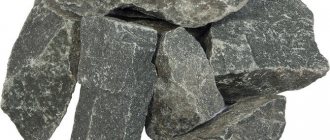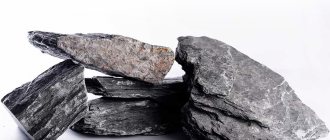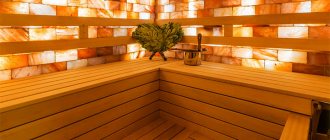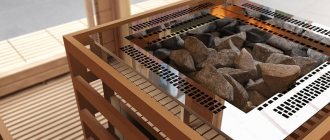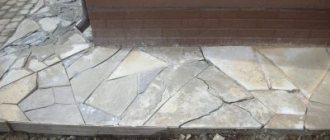Soapstone chlorite. Photo by Leroy Merlin
Not all stones created by nature find active use in human life. But soapstone chlorite was lucky. It has been known and actively used since ancient times in different parts of the world. This continues to this day.
Let’s try to figure out why soapstone is so useful for humans, and also describe the main areas of its application.
Story
Soapstone chlorite, embanked
The history of soapstone chlorite dates back more than one thousand years. This is evidenced by archaeological excavations.
In ancient Egypt and Scandinavia, dishes were made from stone. The mineral heats up quickly, maintains its temperature for a long time and does not absorb cooking ingredients.
In areas with frosty winters, stoves were made from soapstone and used to insulate homes.
In Rio de Janeiro, Brazil, a statue of Jesus Christ was erected from soapstone on a reinforced concrete frame.
Soapstone for baths: reviews
Vasily Alekseevich Belov, 61 years old, Vladivostok
It is better not to lay tiles on the stove with silicate glue, the seams will still crack. I assembled a steel frame around the box and attached the chalcopyrite slabs to the mesh with wire. I once laid tiles on the stove like this. The stone has been standing for two decades now. My neighbor's has already been re-laid with glue twice in the last five years.
Alexey Basnyansky, 43 years old, Ufa
The material is a bomb, but it’s better not to experiment, but to buy a ready-made set of soapstone cladding for a specific firebox model. There is no need to cut anything, everything is ready, even the corner elements and the window under the door - everything was done at the factory. True, the smell of such tiles is terrible, probably because of the paint; you need to burn it for a week to get rid of the feeling of burnt chemicals.
Recommended Posts
Bathhouse 2 by 2, 6 by 9, 3 by 4: log projects Mold
in the bathhouse: how to get rid
High-tech bathhouse, loft and chalet – designer solutions…
Bathhouse with gazebo
Lamps for the bath: for the steam room, for the dressing room, for the washing room
How to treat the outside of a log bathhouse
Other names for the stone
Soapstone figures (Africa)
Soapstone has many other synonymous names that are used in everyday life:
- wen - the stone is called so for its oily sheen;
- hot stone (in Finnish - tulikkivi) - for the property of the mineral to heat up quickly and retain heat for a long time;
- steatite – translated from French as “fat”;
- soap or wax stone - soapstone feels like a piece of soap or wax to the touch;
- stove or pot stone - called depending on the area of application.
What are soapstone whiskey stones?
But here is a question that haunts those who are interested in the culture of drinking alcoholic beverages. “Steatite whiskey stones” sounds attractive enough to make you curious about what kind of stones they are.
In fact, nothing special: if you cool whiskey with ice cubes, they will melt, and the proportion of alcohol in the drink will change, simultaneously changing its taste. Those who would like their whiskey to be both strong and chilled have invented a stone substitute for ice - those same soapstone stones for whiskey.
Properties of soapstone and soapstone stones for whiskey
The high heat capacity of steatite has two opposing applications, although based on the same principle: we have a stone that is colder than the surrounding environment, and there is a principle according to which heat is always transferred from a warmer to a colder object.
Of course, a hot stove and lukewarm whiskey have different amounts of thermal energy, so for soapstone stones to work better, they need to be thoroughly cooled in the freezer . After this, the “rock ice” cubes are ready for use - they will easily take away excess heat from the drink, and the number of degrees will remain the same.
Such cubes are usually made with slightly smoothed edges, while the surface of their edges can be either slightly rough or very smoothly polished. We would still recommend the polished variety - why do you need whiskey with talcum powder?
Physico-chemical characteristics
Soapstone is a magnesium silicate with a complex, constantly changing chemical composition. It consists of three independent minerals - talc, magnesite and chlorite. The main share in the composition of soapstone is magnesite and talc - 40-50% each. The proportion of chlorite, depending on the location of extraction, can reach 8%.
Main characteristics of the mineral:
| Index | Description |
| Formula | Mg₃[(Si, Al)₄O₁₀](OH)₂ × Mg₃(OH)₆ |
| Mohs hardness | 2-3 units |
| Density | up to 3.2 g/cm³ |
| Thermal conductivity | 3.3 W |
| Specific heat | 0.98 kJ/(kg x K) |
| Shine | matte, greasy |
| Transparency | opaque |
| Melting temperature | 1640°C |
Soapstone has a discreet gray color with inclusions of white, green, brown, blue and yellow shades. Specimens of red and cherry color are considered rare.
Peculiarities
Soapstone tiles for baths are considered one of the most suitable materials due to their resistance to high temperatures. At the same time, the properties of heat capacity ensure maximum conservation of thermal energy and its uniform release. The material is not affected by most chemicals, including alkalis and acids. But still, the integrity of the surface can be damaged if strong alkalis come into contact with it.
Place of Birth
Extraction of soapstone chlorite Deposits
of soapstone chlorite are found on almost all continents.
It is mined in industrial quantities in Finland, the USA, Thailand, China, India and Brazil.
Russia ranks second in terms of production volumes among all suppliers of the mineral. The largest deposit is located in Karelia - a mountain ridge runs from the borders of Finland to Medvezhyegorsk. Soapstone chlorite is also mined in the Urals in the Shabrovskoye deposit.
Coil
Serpentine (also serpentinite, apothecary stone) is a dark green rock with a characteristic snake pattern.
Most stones of the serpentine varieties range in transparency from completely opaque to completely transparent, are light (specific gravity between 2.2–2.9), soft (hardness 2.5–4), refractory and susceptible to acids. The shine can be glassy, greasy or silky. Colors range from white to grey, yellow to green, and brown to black, and are often streaked. Stones of this group are found all over the world; New Caledonia, Canada (Quebec), USA (northern California), Afghanistan, Cornwall, China, Asia, France, Norway and Italy are famous countries where serpentine is mined, smoothing out emotional outbursts. If we compare, soapstone chlorite and soapstone magnesite certainly hold heat longer - their heat capacity is higher than that of the coil. However, the coil stone is more durable and less susceptible to external mechanical influence. Do not forget that the conditions in which these stones are used (cladding) are not catastrophic, I would even say the stones are absolutely not loaded, compared to those inside the heater :). That is, it is simply pointless to look for mechanical differences under such conditions of use; they are minimal. The chemical composition is another matter. Above, I wrote about what compounds each rock consists of, but it’s difficult to say what they release when heated and how they can affect health. I know one thing for sure, all these breeds have been used in the bathhouse for centuries, many generations have taken steam baths and remained alive and healthy!
Areas of application
Thanks to its versatile properties, soapstone is widely in demand not only in crafts, but also in the industrial industry.
Construction
Crushed and ground soapstone of technical quality is a raw material for refractories, cement compositions, and electrical insulators.
Soapstone is used to line the walls of residential buildings and swimming pools, and to install “warm floors”. Soapstone is also an excellent soundproofing material.
Arrangement of baths and saunas
Soapstone crushed for baths
Due to its high heat capacity and thermal conductivity, the mineral is used in the construction of baths, steam rooms and saunas. Stone blocks used in baths look aesthetically pleasing, reliable and environmentally friendly.
Drink stones
Soapstone quickly not only accumulates heat, but also cools. In status circles, it is used instead of ice cubes to quickly cool a drink without diluting it with water. To do this, the treated soapstone cubes are placed in the freezer for several hours, after which they are used for their intended purpose. Used pebbles are washed under running water and dried.
Decor
Protective amulet with the Algiz rune, soapstone
Soapstone is plastic and easy to process, so it makes beautiful decorative elements. Vases, figurines, animal figurines, boxes, and souvenirs are made from the mineral. Due to its high thermal conductivity, dishes made of soapstone are in demand. Food cooked in a pot or frying pan made from this stone remains warm for a long time.
Decorations
The stone is not popular among jewelers due to its excessive softness. However, it makes unusual jewelry, set in cupronickel or silver - beads, pendants, pendants.
Where is soapstone used?
Since the stone is really widely known in widely separated areas of the planet, there could be no talk single name Therefore, by now we have several common names that indicate the same stone, although it can vary greatly in color and hardness depending on the place of extraction.
Different names for the stone
So, soapstone is the name given to it by scientists, it describes its main mineral composition: the presence of large proportions of talc and chlorite.
Talkomagnesite is not another name for soapstone, it is a rock with other quantitative characteristics of the content of talc, chlorite and magnesite.
Another common name for this stone is soapstone. It comes from the word “fat”, that is, we can say that the stone is called “wen”.
The reason for this name is the same as the common name “soap stone” - the sense of touch says that the stone is soapy or greasy, it slides in the hand. But in reality, of course, it contains neither soap nor fat - talc is responsible for the corresponding tactile sensations.
Soapstones, piled. Saunamart Photos
Other names are associated with areas of application: for example, if dishes were often made from it, then it was designated as “pot stone”, if it was used in ovens, it was “furnace stone”.
Now that it is clear that we are talking about the same thing, we can move on to areas of application.
Application in construction
If this is not the oldest, it is still the most extensive use of soapstone. However, this does not mean that it was used as the main material for the construction of buildings. Rather, it has always been a facing material.
Although there are exceptions. For example, in the Indian state of Karnataka, about a thousand years ago, a special architectural style was formed, which is associated with the name of the Hoysala dynasty. These are richly carved temple complexes and other buildings. We do not know whether soapstone was used as a load-bearing structure, but it was not a simple cladding either. The parts are massive and form walls, domes and columns. The rich ornamentation would have been too much work for the stone-cutters if the material had not been such a soft stone.
There is also information about the construction of tombs and gravestones made of soapstone. This is practiced, for example, in those parts of North and South America where there are deposits of this rock.
Soapstone facing tiles, polished 150x150x10 mm. Photo Teplokontakt
In Finland, soapstone was also not always just a stove stone. The flourishing of its deposits is connected precisely with construction. This was in the late 19th and early 20th centuries, when Art Nouveau and Art Deco styles were popular throughout the world. The Finns did not lag behind and actively used stone in the cladding of their monumental buildings. But this did not last long - after the 2nd World War there was a decline, and soapstone was revived to a new life as a stone for baths and saunas.
Currently, the main use of soapstone in construction is finishing. In particular, tiles of various shapes and sizes are made from it, which can be used to decorate walls and floors, as well as building facades. (We write about tiles here).
In addition, in the interiors there are countertops, sinks and shower trays made of steatite.
Before we go further, let’s clarify some of the properties of soapstone stone. While the stone is “fresh”, it can be processed even with a knife (although it all depends on the amount of talc and magnesite). But then, when the product is in the fresh air, exposed to all atmospheric phenomena, some of the bound moisture leaves it over time Both increase the hardness of the stone. But this applies to areas with a more or less dry climate. However, even in South India, many temples have survived to this day, although there are also destructions. The interior decoration is better preserved than the exterior.
In the furnace business
Furnace business, and, more broadly, everything related to heat accumulation is another wide area of application of soapstone.
It has long been noticed that stone hardly heats up to scorching temperatures, but at the same time remains warm for a very long time .
This quality was used in a variety of ways: blocks were heated on kitchen stoves and then placed in bed to get rid of excess moisture and warm it up before bed; other blocks were also heated before a long sleigh ride - they were placed under the feet and under the arms, making the journey more comfortable .
Hephaestus PB-03M cast iron sauna stove + President 1000/50 soapstone lining. Photo Teplokontakt
And the furnaces themselves were even entirely made (and are still made) from soapstone. That is, this is the direct ancestor of the brick oven, which only contains doors from metal parts.
We wrote about soapstone and soapstone magnesite stoves here and here.
Although a pure stone stove is still rare. Much more often you can find metal stoves that are only lined with soapstone.
In the manufacture of dishes and art objects
Pottery stoneware can also be found in both hemispheres. It is traditionally traded in Brazilian in our time. And once upon a time, the Vikings (who, it turns out, not only robbed, but also traded) made so much stone utensils that they had enough to cover their own needs and to sell to their neighbors.
The Indians of North America also made stone utensils. And the northernmost peoples of SA - the Inuit or Eskimos - had stone lamps made of soapstone, which they used to illuminate their homes.
In any case, stone ware does not require firing, like ceramic ware, so it is much easier to manufacture and can be made at earlier stages of the development of civilization.
What kind of dishes were in use? Anything - from bowls and cups to frying pans and cauldrons; stoves were also used for cooking, on which a thin layer of, say, dough was thermally processed. Of course, these are not dishes, rather “two in one” - a stove-frying pan.
As for art objects, most often these are figurines. However, there are also statues - Christ the Redeemer, with his arms outstretched over Rio de Janeiro, is a statue whose outer layer is made of soapstone.
Harvia Soapstone cup for Combi Topclass stove. Saunamart Photos
Figurines are found on all continents, excluding, of course, Antarctica. From the African Yoruba and ancient Egyptians to the Chinese, Indians and Indians - everywhere the material is in demand and reproduces the traditions characteristic of a particular nationality.
There is a difference between “architectural” and “sculptural” soapstone - it lies in the talc content. If the first should not contain more than 30%, then for the second the permissible content reaches 80%. This circumstance greatly facilitates the work of the master, allowing him to reproduce the smallest details of ornaments or figures.
In addition to figurines, you can find references to smoking pipes and carved seals.
Other
They pave roads with soapstone and use it to make molds when casting silver , it is pressed and fired, obtaining a good refractory with a higher hardness than the original material, ceramics are made from it, which is used for the manufacture of high voltage insulators and for other purposes, it is a good marker for both seamstresses and welders (the latter is useful for its heat resistance).
Therapeutic effect
Bowl for aroma oils made of soapstone
Lithotherapists attribute biostimulant properties to soapstone. Its effectiveness has been proven in the following cases:
- improvement of brain function - memory restoration, increased concentration and logical thinking;
- treatment of hypertension, normalization of blood pressure by lowering it;
- treatment of osteochondrosis, radiculitis, Lumbago disease;
- increasing immunity;
- fight against viral and respiratory diseases.
There is an opinion that the stone releases vitamin D, which has a beneficial effect on the functioning of the musculoskeletal system, but representatives of traditional medicine do not confirm this.
To alleviate health conditions, they use soapstone heating pads, pebbles for massage, beads and simply amulets made of untreated stone.
What properties should stones for a stove have?
Not every stone is suitable for filling in a sauna stove. Without knowing the stones and their properties, you should not put them in the heater. Heating of stones is thermal radiation that affects the body.
Even very beautiful and suitable unknown stones on a river or road should be avoided. These breeds are unknown to you, their radiation can be hazardous to health.
Round or oval shaped stones are the most suitable option for filling the furnace.
It makes absolutely no difference whether it is closed or open.
Natural gaps are formed between the laying of oval or round stones; it is easier for hot air to pass through them.
Smooth stones last longer in the kiln. There are no chips or nicks in such stones; cycles of heating, cooling and thermal shock with water do not lead to their rapid destruction.
The size of the stones must correspond to the size of the backfill site. It is unwise to fill large containers with small stones.
Before purchasing stones, be sure to consider their sizes and pay attention to their structure.
Price
Stone cubes for whiskey
The price of soapstone depends on the place of extraction of the mineral, its dimensions, color and quality of processing. The most expensive raw materials are those mined in Finland.
The cost of soapstone products is as follows:
- $16 – for a massager made of soapstone;
- $37-62 – for soapstone cubes for whiskey from Karelia in the amount of 10 pcs. depending on size;
- $60 – for a souvenir ball with a diameter of 50 mm;
- $100-110 for an animal figurine made of soapstone up to 12 cm high.
Benefit
The popularity of soapstone as a bath stone is due to the healing properties of the mineral.
. He is appreciated for the fact that he:
- treats colds;
- eliminates inflammatory processes;
- improves metabolism;
- normalizes blood pressure.
It is believed that the stone is also endowed with healing “magical” properties. It is especially useful for men's health. It helps to cope not only with potency disorders, but also to avoid difficulties in your personal life.
Soapstone is an accessible mineral. You can purchase it for a price starting from 15 rubles. for 1 kg.
Source Sauna Life
Soapstone in astrology
Amulet made of soapstone
When choosing soapstone as a magical amulet or talisman, you should take into account its compatibility with the zodiac:
- The stone is ideal for Gemini, Pisces, Virgo and Libra. Representatives of these zodiac signs will gain calm and self-confidence, and get rid of their inherent fears and anxieties.
- Scorpios, Aquarius, Cancers and Capricorns can use soapstone, but not all the time. Otherwise, they may lose vigilance and confidence in their abilities.
- Taurus, Leo, Sagittarius and Aries are not recommended to wear this stone, as it negatively affects their character. Such negative qualities of these zodiac signs as ambition, selfishness and irritability increase several times when in contact with soapstone.
Use in baths
Thanks to such distinctive characteristics as high heat capacity and good thermal conductivity, inexpensive soapstone for baths has become a real find. Able to withstand high temperatures, durable mineral rock is capable of maximizing thermal energy accumulation, storing it for a long period and gradually releasing it. Soapstone has become a popular stone in bathhouses for cladding and masonry of stoves.
For cladding, such a characteristic of stone as resistance to mechanical stress is also of no small importance. When sawing, it does not crumble or break. Builders often make tiles called “ragged stone”, assembled from sawn parts of the mineral.
In addition, the high chemical stability of the mineral allows it to withstand even strong acids. Only fairly strong alkaline compounds can corrode its surface.
What is the difference from a fake?
Soapstone tiles 200*50*20
Soapstone is rarely counterfeited, using plastic as an imitation. It is quite simple to distinguish the original from the fake:
- soapstone is soft and easy to scratch and damage;
- this mineral has a heterogeneous color and discreet color;
- Soapstone leaves a white streak when rubbed across glass or other hard object.
Much more often soapstone is used to imitate jade because of its greenish color. The difference between the minerals is that the hardness of jade is higher compared to soapstone.
Dimensions of soapstone bricks and tiles
As a rule, tiles are produced in several versions:
- Elements with standard geometry (30x30, 25x30, 20x30, 30x60, 60x60 cm with a thickness of 1 or 2 cm). The decorative effect is achieved by polishing.
- Slab is a large-sized plate. It is not as large as, for example, marble or granite. The parameters can be as follows: 30x60, 30x90 cm with a thickness of 4 to 7 cm.
- Ragged stone soapstone. It is called torn due to its rather rough terrain with irregularities. Tile sizes are 15x40, 15x50, 20x40, 20x50 cm with a thickness of 2 or 2.5 cm.
To make it more decorative, soapstone is artificially aged.
Brick is sold in slightly different sizes and thicknesses - 25x12.5x4 cm, 25x12.5x5 cm, 25x12.5x6 and 25x12.5x6.5 cm.
Classification
Chlorites are a large family of mica-like minerals with a complex chemical composition, which is why their varieties are determined. These include:
- pennine;
- talc – chlorite;
- corundophilite;
- clinochlor;
- pseudothuringitis;
- delessit;
- chamosite;
- brunswigite;
- thuringite;
- kochubeite – clinochlore;
- Nickel chlorite;
- kemmererite - pennine;
- kukeit;
- pennantite;
- gonerite;
- manandonite;
- grohauite;
- kakleichtenbergite;
- afrosiderite;
- grengesite;
- bavalit;
- nibble;
- chamosite.
Chemical composition and physical properties
If we are talking about pure magnesian chlorites, then their ideal chemical formula can be depicted as follows: Mg3Si4O10(OH)2*Mg3(OH)6. Often magnesium can be replaced by Al, Fe, Ni, Cr, Mn. Although the general chemical formula for Chlorites looks like this: (Mg,Fe,Al,Cr,Ni,Mn)3(Si,Al)4O10(OH)2*(Mg,Fe,Mn)3(OH)6.
If we take into account the structure of Chlorites, these are typical layered silicates, which in many respects are similar to micas. Crystallization occurs in the form of a monoclinic system; they have mica-like cleavage, low specific gravity and relatively low hardness. Thin leaves, which have significant flexibility, but lack elasticity, can be easily split off from crystalline chlorites. This is a feature of their crystal lattice.
From a chemical point of view, chlorites belong to the category of aluminosilicates, the typical impurities of which are aluminum, magnesium, ferrous iron, chromium, and nickel. Such magnesium-enriched ores are called orthochlorites.
| Basic physical properties | |
| singonia | monoclinic, pseudohexagonal |
| Hardness | 2,0 – 3,5 |
| Cleavage | very perfect |
| Density g/cm3 | 2,6 – 3,02 |
| Specific gravity | small |
| Refractive indices | 1.63 |
| IMA class | silicates |
| Selection form | in nature there are aggregates of leafy and radial-radiant appearance, crystalline formations of tabular and prismatic appearance, as well as cryptocrystalline and granular masses |
| Kink | stepped |
| Fragility | Yes |
| Strength | sufficient flexibility |
Chlorite deposits
These minerals predominate in metamorphic rocks, where entire strata of these precious stones are formed. The most famous deposits are the Republic of Crimea, Ukraine, Kazakhstan, Siberia and Transbaikalia, the Urals and the North Caucasus. But there are other regions where this stone is mined. These include Georgia, Uzbekistan, Kyrgyzstan, and Tajikistan.
Switzerland and Italy can boast of deposits, where the Pennine Alps are located, rich in pennine - a mineral classified as Chlorites and having a beautiful appearance.
How to choose a stone for a bath
When building a bathhouse, most people pay great attention to the decoration of the steam room, carefully selecting wood for the walls and benches. At the same time, the question is: “Which stone to choose for a bath?” usually not worth it. And it’s completely in vain, because the atmosphere in the steam room and its healing properties depend on the choice of the type of stones.
Classic Russian steam room
However, any bathhouse owner sooner or later comes to the question of choosing stones. The stones, chosen at random, begin to crumble and crack, the atmosphere in the steam room leaves much to be desired, and you can feel the difference between visiting your own bathhouse and a sauna with friends. Of course, a thrifty owner asks this question even when building a bathhouse, but better late than never.
Description and external signs
The term “chlorites” refers to a whole group of gems, the deposits of which are scattered throughout almost the entire territory of the globe. What do these stones look like? Their shades are varied. You can find specimens of light yellow color, and sometimes there are dark green, almost black. There are also white stones. The shade of a mineral depends on its variety, of which more than twenty have been identified. The crystals have a pearlescent, oily or glassy luster and a white streak. As for transparency, chlorites can be translucent or clearly translucent in the thinnest plates.
TOP 16 best stones for baths
To obtain pleasant and light steam, building a sauna is only half the battle. It is equally important to properly equip the heater - to select durable minerals that accumulate heat well and give off heat for a long time, preferably with a healing effect. This article is an overview of the best bath stones, both natural and artificial. By studying their properties, advantages and weaknesses, you reduce the risk of encountering compounds harmful to your health to almost zero and will be able to buy stones with the desired characteristics.
